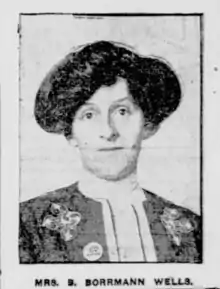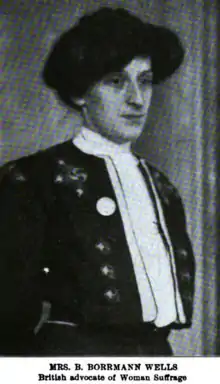
January 20, 1907

March 1907
Bettina Borrmann Wells (born 1874) was a Bavarian-born English suffragette who toured the United States as an organizer and lecturer. (She rejected the term "suffragist" for her work, preferring "suffragette".)
Early life and education
Bettina Borrmann was born in Nuremberg, Bavaria, and was a graduate of the University of Geneva.[1] In 1914, 1915, and 1916 she earned bachelor's and master's degrees in economics and psychology at Columbia University.[2][3] Her master's thesis was titled "The economic basis of the present feminist movement" (1915).[4]
Suffragette
Bettina Borrmann Wells was a member of the Women's Social and Political Union.[5] In November 1908, Bettina Borrmann Wells served a three-week sentence in Holloway Prison,[6] for "obstructing a policeman" at a demonstration in London.[7] She called herself a "suffragette", explaining that "a suffragette is a suffragist who is willing to die for the cause."[8] By 1910 Wells had moved away from Emmeline Pankhurst's arm of the movement[9] and she was very active in the Manchester wing of the Women's Freedom League.[10] In 1911 an American newspaper described her as head of the propaganda department of the "Women's Federation League" of England.[11]
Activities in the United States
In the United States in 1908, Wells, Maud Malone, Christine Ross Barker, Sophia Loebinger, and others organized open-air meetings of the Progressive Woman Suffrage Union in New York City's Madison Square, Wall Street, Harlem, and Brooklyn,[12][13] against significant resistance from the city's residents and business leaders.[14][15][16] In spring 1908, Wells and Malone led a suffrage parade in New York City, without a permit.[17] Later that year, Wells and three other suffragists attempted to meet with Theodore Roosevelt in Oyster Bay, New York, but they were rebuffed by the Secret Service.[18]
She toured the United States and Canada[19] with her husband, meeting with suffrage activists in various cities.[20] "Women will only get the vote when they make men believe they are serious and will pay the price for it," she told an audience in Brooklyn, "They won't get it by arranging for pink teas and yellow bazars."[21] In 1909 she published a pamphlet, America and Woman Suffrage, detailing suffrage activities in Wyoming, Utah, Colorado, and Idaho.[22]
Wells also wrote pro-suffrage letters to the editor, both in Great Britain[23] and in the United States.[24] "I admit that 'better laws have passed without any vote of woman'," she conceded in one 1908 letter to the New York Times. "One can also get to California on foot, but most of us prefer speedier methods of traveling."[25]
Wells traveled to Washington, D.C. in January 1917, to take a turn as one of the "Silent Sentinels" picketing the White House, in the early weeks of that protest.[26][27]
Personal life
Bettina Borrmann married English businessman Herbert James Clement Wells in 1900. She was a member of the Lyceum Club of London, and of the Society of Women Journalists of London.[28]
References
- ↑ "Suffragette Leader to Talk in Chicago" Inter Ocean (April 7, 1908): 3. via Newspapers.com

- ↑ Catalog (Columbia University 1918): 386.
- ↑ Catalog (Columbia University 1919): 385.
- ↑ Bettina Borrmann Wells, "The economic basis of the present feminist movement" (Columbia University, master's thesis 1915).
- ↑ Mrs. B. Borrmann Wells, "The Suffragette Movement" New York Times (February 19, 1907): 8. via ProQuest
- ↑ "Suffragists Invade Opposition Meeting" New York Times (December 5, 1908): 2. via ProQuest
- ↑ Allan L. Benson, "The Hopes of the Suffragette in America" New York Times (December 13, 1908): SM7. via ProQuest
- ↑ "In Fighting for the Ballot" New-York Tribune (April 2, 1909): 8. via Newspapers.com

- ↑ "Hitting Mrs. Pankhurst" Montreal River Miner and Iron Country Republican (January 14, 1910): 6. via Newspapers.com

- ↑ Elizabeth Crawford (2 September 2003). The Women's Suffrage Movement: A Reference Guide 1866-1928. Routledge. pp. 125–. ISBN 1-135-43402-6.
- ↑ "Miss Borrmann Wells" Central New Jersey Home News (March 24, 1911): 8. via Newspapers.com

- ↑ "Suffragists Lose Hearer" New York Times (January 22, 1908): 5. via ProQuest
- ↑ "Suffragettes Win the East Side Boys" New York Times (March 22, 1908): 5. via ProQuest
- ↑ "Suffragettes Protest" New York Times (April 30, 1908): 16. via ProQuest
- ↑ "Wall St. Derides the Suffragettes" New York Times (February 28, 1908): 7. via ProQuest
- ↑ "Suffragettes Do Not Like Harlem" Billings Gazette (April 29, 1908): 8. via Newspapers.com

- ↑ Linda J. Lumsden, Rampant Women: Suffragists and the Right of Assembly (University of Tennessee Press 1997): 73-74. ISBN 9781572331631
- ↑ "Oyster Bay Frowns on Suffragettes" New York Times (August 6, 1908): 5. via Newspapers.com

- ↑ "Pitchfork for Brooklyn, Policy of Suffragettes" Brooklyn Daily Eagle (January 22, 1909): 3. via Newspapers.com

- ↑ "Suffragette Leader Comes to Pittsburg" Pittsburgh Press (April 23, 1908): 1. via Newspapers.com

- ↑ "No Respect at Albany" Brooklyn Daily Eagle (March 5, 1909): 5. via Newspapers.com

- ↑ B. Borrmann Wells, America and Woman Suffrage (1909). from the Ann Lewis Women's Suffrage Collection.
- ↑ B. Borrmann Ann Wells, "Women's Suffrage" Archived 2018-05-27 at the Wayback Machine Llandudno Advertiser (February 12, 1910): 3. via Welsh Newspapers Online

- ↑ "Mrs. Wells Misquoted" New York Times (February 23, 1909): 8. via ProQuest
- ↑ Mrs. B. Borrmann Wells, "Votes for Women" New York Times (December 20, 1908): 10. via ProQuest
- ↑ "British Suffragist is Picket" Washington Post (January 26, 1917): 2. via Newspapers.com

- ↑ "British Suffragist is on Picket Duty" Evening Star (January 25, 1917): 12. via Newspapers.com

- ↑ Columbia University, Officers and Graduates (1916): 1023.